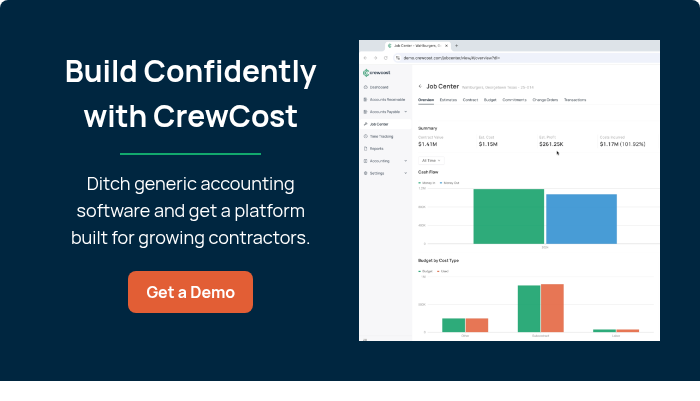The Construction Industry is Cash-Intensive
It’s no secret that construction runs on cash. From purchasing materials and labor to tools and equipment, contractors and construction firms are usually required to make significant short-term outlays to get construction projects up and running.
These cash outflows often remain throughout the life of a project. While this constant movement of money isn’t a negative in and of itself, slow payments can quickly become a problem. And if you can’t recoup those upfront project costs, meeting your profit margin goals becomes much harder.
The Challenge of Slow Payments in Construction
Unfortunately, delayed payments aren’t uncommon in construction. According to the 2022 Construction Financial Management Association (CFMA) Benchmarker Report, the average accounts receivable takes more than 60 days to be paid in, versus an average of just 26 days for accounts payable.
Add on ongoing expenditures like weekly payroll, materials, and progress payments for subcontractors, and it’s easy to see just how detrimental slow payments can be to your financial health. That gap between incoming payments and outgoing spending means good cash flow management is fundamental if you want to avoid cash shortages.
5 Tips on Proactive Construction Cash Flow Management
The best way to improve cash flow is to get proactive in your financial planning by building accurate inbound and outbound cash flow forecasts. You should also give proper weight to project timelines, understand payment terms, and get ahead of any roadblocks that could cause delays.
It’s also a good idea to keep a sizable amount of money on hand to cover any gaps between incoming payments and outgoing expenses. Most contractors understandably want to take out their profit every year because they don’t want to lose what they’ve already earned, but this can set you up for tough situations down the line. For example, if you’ve got 10 employees and are only working with a $10,000 buffer year after year, you’ll always be skating on thin ice. Your ability to have cash on hand is directly tied to your business’s longevity, especially when things get hard. In our experience, it’s best to slowly build up that reserve as you bring in profit over time.
Here are a few best practices to help you maintain healthy cash inflows, streamline billing cycles, and make sure you’ve got a decent reserve on hand:
1. Request better payment schedules from vendors. Try asking for a net 45 payment structure versus the industry standard of net 30 on your accounts payables. Also, if an upstream contractor is giving you paid-when-paid terms, use those same terms if you have someone subcontracting below you.
2. Make sure you’re not underbilling on your invoices to project stakeholders. Always double-check your calculations, and make sure change orders are approved! Monthly job cost reviews will help you stay on top of accurate billings.
3. Maintain a good working relationship and line of credit with your bank. You want to be able to have cash on hand very easily, so try to avoid waiting till you’re in a crunch to get a credit line. It’s much harder to get financing in place then than when your business is operating well. If you’re just starting out, be sure to regularly revisit the interest charged on your credit line and try to negotiate a better rate.
4. Focus on faster payment of accounts receivable. Establish policies to make sure billings are received and accepted by the party being billed, schedule follow-ups a week before the due date, and have procedures for pursuing unpaid invoices. Remember, the squeaky wheel gets the grease.
5. Build and maintain a healthy cash surplus so you can overcome inevitable slow payments. This can take some time to build up, but will give you the resources to weather the inevitable slowdowns in construction. Start off with a goal of having three months of payroll cost as your back up, then decide what amount helps you sleep well at night.
How Technology Can Improve Your Bottom Line
The good news is, there are a lot of financial and project management tools out there that make cash flow management easier. For example, construction accounting and financial management software like CrewCost helps track expenses, manage invoices, and provide a clear view of your company’s financial health in real-time. Try it free for 30 days (no credit card required).
With these tools, you can easily manage project cash flow, measure your business’s liquidity, and predict and prevent problems before they get out of hand.
Wrapping Up
You know how the saying goes: Cash is king in construction. Though navigating our industry’s finances can be a headache, understanding cash flow and taking advantage of cash management tools can help your business overcome financial obstacles and grow for years to come.
To learn everything you need to know about setting up a process for construction accounting that will help you build a more profitable business, check out the Ultimate Guide to Construction Accounting for Emerging Contractors.

